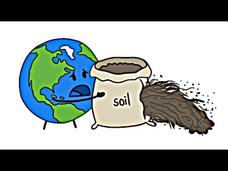Deep Look
This Pulsating Slime Mold Comes in Peace (ft. It's Okay to Be Smart)
Can you name an organism that isn't a plant, animal, or fungus? Here's a hint: each cell contains thousands of nuclei. Slime mold may not have any appendages, but their movements fascinate scientists. The video focuses on these unique...
Deep Look
Sticky. Stretchy. Waterproof. The Amazing Underwater Tape of the Caddisfly
Did you know that the caddisfly creates a tape that is not only water proof, but also stretches like a rubber band. Learn more about caddisflies with a video explains What scientists are discovering about an insect with aquatic larvae.
Fuse School
Types of Chemical Industries
Four percent of the world's CO2 emissions come from the chemical industry. The video discusses the environmental impact of industry. From using non-renewable resources, requiring high levels of energy, to polluting the ground, water, and...
MinuteEarth
How To (Literally) Save Earth
Soil naturally erodes and produces new soil at the same rate when left to nature, yet farming erodes the soil 50 times faster than it forms. The video discusses soil, the ways humans damage it through their actions, and encourages many...
MinuteEarth
Why Do Rivers Have Deltas?
What determines the shape of the shoreline where a river meets an ocean? The video explains many causes for delta formation, including human activities and climate change. Also included are examples from around the world and throughout...
MinuteEarth
What Happened To This Car?
On June 7, 1692, at 11:43 am, the Jamaican city of Port Royal sank into the harbor, killing more than 2,000 people. The video explains this disaster and others that were caused by liquefaction, describes the conditions required, and...
MinuteEarth
How Tall Can Mountains Be?
Currently, the tallest mountain on Earth is Mount Everest at 8,848 meters above sea level. The video discusses how tall a mountain might reach based on gravity, rock density, and other factors such as plate tectonics and erosion.
MinuteEarth
The Hottest Place on Earth
Where is the hottest place on Earth, and how can scientists prove it? The video discusses multiple methods for measuring the temperatures across the planet. Then it discusses the hottest places measured by each method and their accuracy....
MinuteEarth
Which Bear Is Best?
Is it survival of the fittest, or just luck? The video focuses on two examples, bears and ferrets, living in North America and Asia. It explains which animals are thriving and which are in danger of going extinct and the reasons.
MinuteEarth
Epigenetics: Why Inheritance Is Weirder Than We Thought
Can learned traits be passed down to future generations? The video explains epigenetics, which is the change in organisms caused by a modification of genes and not the genetic code. Using the example of lab rats passing on a sensitivity...
MinuteEarth
The Great North American Locust Plague
The largest locust swarm recorded in North America measured 110 miles wide and 1,800 miles long, making it roughly twice the size of Colorado. A video begins with what locusts are and where they came from then explains the damage they...
MinuteEarth
How Different Are Different Types of Dogs?
The American Kennel Club currently recognizes 167 dog breeds while the Federation Cynologique Internationale recognizes 340. The video explains the three main categories of dogs and how closely those dogs are related. It offers...
MinuteEarth
Birds that Hibernate in Lakes?!
Birds seem to disappear at various times of the year, and many early theories about this phenomenon turned out to be wrong. The video introduces two of these theories as well as how scientists learned the truth. It explains a few...
MinuteEarth
Five Crazy Bridges for Animals
How did the chicken cross the road? The video addresses the multiple solutions we created to help animal populations cross roads, power lines, and dams. It explains the reason human-made obstacles hurt animal populations and why it...
MinuteEarth
Why do Bats Transmit so many Diseases like Ebola?
In many different areas of the world, bats spread diseases that kill humans. Understanding how this happens may be the key to our survival. The video explains the diseases carried by bats, how they spread to other species, and the reason...
MinuteEarth
Why Don't Scavengers Get Sick?
Scavengers eat diseased animals, yet don't get sick. The video explores this topic through examples of vultures and beetles. One method sprays the decaying meat prior to eating. The other method relies on strong stomach acid to break...
MinuteEarth
How Many Mass Extinctions Have There Been?
Everyone knows about the extinction of the dinosaurs, but what other mass extinctions have happened? The video explains how scientists define mass extinctions. It offers insight into the debate about the number of mass extinctions as well.
MinuteEarth
This Is Not a Pine Tree
Many people refer to all coniferous trees as pine trees and the video addresses that misconception. It details the differences in pines, spruces, firs, and other related trees. Then it shares the family of trees and their branches.
MinuteEarth
Poop Transplants!
Do people really take pills filled with poop? The video answers this question with a surprising "yes." It explains the illnesses fecal transplants treat, the effectiveness, and why the research is limited. It compares the procedure to...
MinuteEarth
How Your Dog Can Protect You Before You're Born
Are there things mothers can do to prevent their unborn children from having asthma? It turns out the answer is related to the household pets. The video explains how dogs and cats seem to protect the health of babies and children. It...
MinuteEarth
Why We Sucked at Counting Fish (Until Now)
Are there more fish in the ocean or stars in the galaxy? The video begins with explaining the old method for estimating the number of fish in the ocean. Then it details the new method using SONAR. The differences in estimates lead...
MinuteEarth
Can Math Explain How Animals Get Their Patterns?
Most people think of a mathematical pattern as a series of numbers. A video discusses how math might explain the patterns of spots, stripes, and other shapes found on animals. It begins with the observation of various patterns, then...
MinuteEarth
How to Date A Planet
The earth is literally older than dirt, but how can we prove it? The video explains the methods used to find the age of the moon and the earth. It offers a quick overview of the rock cycle, geologic processes, and the impact of...
MinuteEarth
The Mystery of Asparagus Pee
Why does asparagus change the smell of urine? The video discusses this from multiple perspectives. It considers the olfactory senses, the sulfur compounds digested, the perception, and other factors that contribute to this concept. It...























